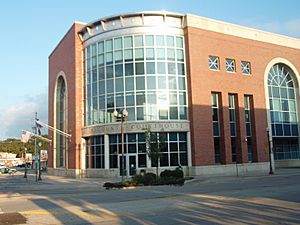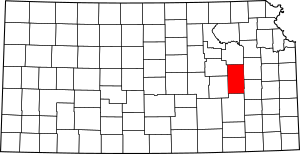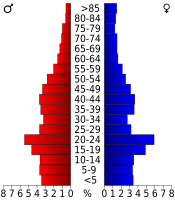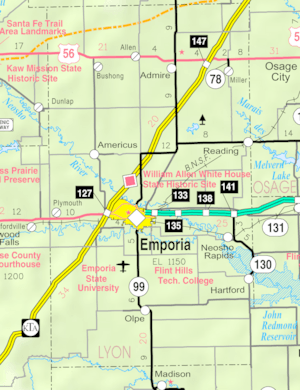Lyon County, Kansas facts for kids
Quick facts for kids
Lyon County
|
|
|---|---|

Lyon County Courthouse in Emporia (2009)
|
|

Location within the U.S. state of Kansas
|
|
 Kansas's location within the U.S. |
|
| Country | |
| State | |
| Founded | February 5, 1862 |
| Named for | Nathaniel Lyon |
| Seat | Emporia |
| Largest city | Emporia |
| Area | |
| • Total | 855 sq mi (2,210 km2) |
| • Land | 847 sq mi (2,190 km2) |
| • Water | 7.9 sq mi (20 km2) 0.9%% |
| Population
(2020)
|
|
| • Total | 32,179 |
| • Estimate
(2023)
|
32,172 |
| • Density | 38.0/sq mi (14.7/km2) |
| Time zone | UTC−6 (Central) |
| • Summer (DST) | UTC−5 (CDT) |
| Congressional district | 2nd |
Lyon County is a county located in the state of Kansas in the United States. Its main city and county seat is Emporia. In 2020, about 32,179 people lived there. The county is named after Nathaniel Lyon, a general who died during the American Civil War.
Contents
History
Early history of Lyon County
For thousands of years, the Great Plains of North America were home to nomadic Native American groups. They moved around to hunt and gather food.
From the 1500s to the 1700s, France claimed large parts of North America. After a war with Great Britain, France secretly gave its land to Spain in 1762.
19th century changes
In 1802, Spain returned most of this land to France. Then, in 1803, the United States bought a huge area, including most of what is now Kansas, from France. This was called the Louisiana Purchase. It cost about 2.83 cents per acre.
In 1806, an explorer named Zebulon Pike traveled west from Missouri. Part of his journey followed the Cottonwood River through what would become Lyon County.
In 1854, the Kansas Territory was created. Kansas officially became the 34th U.S. state in 1861. Lyon County was formed in 1862 from an area previously known as Breckinridge County.
In 1871, the Atchison, Topeka and Santa Fe Railway built a major train line through Emporia. This helped the county grow and connect with other places.
Geography
Lyon County covers a total area of about 855 square miles. Most of this area, about 847 square miles, is land. The remaining 7.9 square miles, or 0.9%, is water.
Neighboring counties
Lyon County shares borders with several other counties:
- Wabaunsee County (to the north)
- Osage County (to the northeast)
- Coffey County (to the southeast)
- Greenwood County (to the south)
- Chase County (to the west)
- Morris County (to the northwest)
Protected natural areas
Part of the Flint Hills National Wildlife Refuge is located in Lyon County. This refuge helps protect wildlife and their habitats.
Demographics

| Historical population | |||
|---|---|---|---|
| Census | Pop. | %± | |
| 1870 | 8,014 | — | |
| 1880 | 17,326 | 116.2% | |
| 1890 | 23,196 | 33.9% | |
| 1900 | 25,074 | 8.1% | |
| 1910 | 24,927 | −0.6% | |
| 1920 | 26,154 | 4.9% | |
| 1930 | 29,240 | 11.8% | |
| 1940 | 26,424 | −9.6% | |
| 1950 | 26,576 | 0.6% | |
| 1960 | 26,928 | 1.3% | |
| 1970 | 32,071 | 19.1% | |
| 1980 | 35,108 | 9.5% | |
| 1990 | 34,732 | −1.1% | |
| 2000 | 35,935 | 3.5% | |
| 2010 | 33,690 | −6.2% | |
| 2020 | 32,179 | −4.5% | |
| 2023 (est.) | 32,172 | −4.5% | |
| U.S. Decennial Census 1790-1960 1900-1990 1990-2000 2010-2020 |
|||
Lyon County is part of the Emporia, KS Micropolitan Statistical Area. This means Emporia is a central city for the surrounding smaller communities.
In 2000, there were about 35,935 people living in the county. The population density was about 42 people per square mile. The population was spread out, with many young people and a good number of older adults.
Education
Colleges and universities
- Emporia State University in Emporia
- Flint Hills Technical College in Emporia
Unified school districts
School districts in Lyon County include:
- North Lyon County USD 251
- Southern Lyon County USD 252
- Emporia USD 253
Some school district offices are located in neighboring counties but serve parts of Lyon County:
- Chase County USD 284
- Lebo-Waverly USD 243
- Madison-Virgil USD 386
- Morris County USD 417
- Wabaunsee East USD 330
Communities

Lyon County has several cities and smaller communities.
Cities
Unincorporated communities
These are smaller communities that are not officially organized as cities:
Notable people
Many interesting people have connections to Lyon County.
- R. Lee Ermey (1944–2018) was born in Emporia. He was a retired Marine and a famous actor. He was known for playing strong authority figures, like in the movie Full Metal Jacket and as the voice of Sarge in the Toy Story films.
- Homer Woodson Hargiss was a creative college football coach. He was one of the first coaches to use the forward pass in football games, even before it became popular. He also helped invent the "huddle," where players gather to plan their next move.
- Jerry Kill is a successful college football coach. He has won over 100 games in his career, coaching teams like the Minnesota Golden Gophers.
- Dean Smith is a retired head coach of men's college basketball. He was born in Emporia. He is considered a "coaching legend" and led the University of North Carolina at Chapel Hill team for 36 years. His teams won two national championships.
- William Allen White was a well-known American newspaper editor, politician, and author. He won a 1923 Pulitzer Prize for his writing. He was a leader in the Progressive movement, which aimed to improve society.
- Maud Wagner was the first known female tattoo artist in the United States. She was also a circus performer and traveled with her husband, showing off their tattoos and creating new ones for others.
See also
 In Spanish: Condado de Lyon (Kansas) para niños
In Spanish: Condado de Lyon (Kansas) para niños

